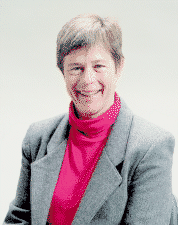
Director, Aizu History Project
Formerly, Professor, Center for Cultural
Research and Studies
University of Aizu, Japan
Ph.D.
1977 (University of California, Berkeley),
M.A. 1971 (University of California, Berkeley)
Before coming to the University of
Aizu, Professor
Goodwin taught in the Department of History at the University of
California, Los Angeles, and in the
Department of East Asian Languages and Cultures at the University of
Southern California. In addition
to offering courses in her specialty, the history of
pre-modern Japan, she also taught courses in modern
Japanese history and civilization, Japanese
literature, Japanese religion, the history of
Japanese women, and the history of outcasts,
vagabonds and other marginals in Japanese society.
While studying for her Ph.D. she spent a year as a
pre-doctoral fellow in the Department of Religion at the University of
Kyoto.
She has been awarded a Fulbright Scholarship for
1993-1994 to conduct research on gender and
marginality in medieval Japan. Her other awards
include grants from the Northeast Asia Council of the
Association for Asian Studies, and a National Defense
Foreign Language Fellowship. She is a member of the
Association for Asian Studies and the American
Historical Association.
- Medieval Japanese religious history
- Gender and marginality in medieval Japan
- History of the Aizu region
A challenging task in history today is the
study of non-elites, such as peasants, artisans,
entertainers, and vagabond ascetics and religious
proselytizers. Since it was generally elites who
wrote histories and kept records in the past,
standard historical accounts have too often ignored
non-elites, treated them as objects, or lumped them
together as statistics. Non-elites, however, were
often the agents of historical change; and even
public decisions made by rulers were influenced by
patterns of daily life and by compliance or
resistance on the part of ordinary people.
Understanding a society's past, in other words,
demands that we understand the entire society, not
just its most powerful and articulate segments.
My previous work on medieval Japanese Buddhist
institutions examined the contributions of
ordinary people to the construction of temples, and
the role of vagabond ascetics in securing these
contributions and in building both physical and
communal structures. My current research project is
focused on medieval Japanese women of marginal
status, such as prostitutes, entertainers, and
wandering shamans; I will explore the survival
strategies of marginalized people in a study that
should have broad implications for all periods of
Japanese history. Finally, in a
planned project on the history of the Aizu region, I
intend to examine the relationship between a
peripheral region and the center of political power,
as well as internal dynamics of oppression and
resistance.
-
Selling Songs and Smiles: The Sex Trade in Heian and Kamakura
Japan,
University of Hawaii Press, 2007.
-
Alms and Vagabonds: Temples and Popular Patronage in Medieval
Japan,
University of Hawaii Press, 1994.
- "The Buddhist Monarch: Go Shirakawa and the Rebuilding of
Todaiji",
Japanese Journal of Religious Studies, Vol. 17, 2-3, 1990.
- "Shooing the Dead to Paradise",
Japanese Journal of Religious Studies, Vol. 16, 1, 1989.
- "Building Bridges and Saving Souls",
Monumenta Nipponica, Vol. 44, 2, 1989.
- "Alms for Kasagi Temple",
Journal of Asian Studies, Vol. 46, 4, 1987.
e-mail:Jan Goodwin
jan@cs.csustan.edu
WWW: https://www.cs.csustan.edu/~jmg/ah/jan.html
